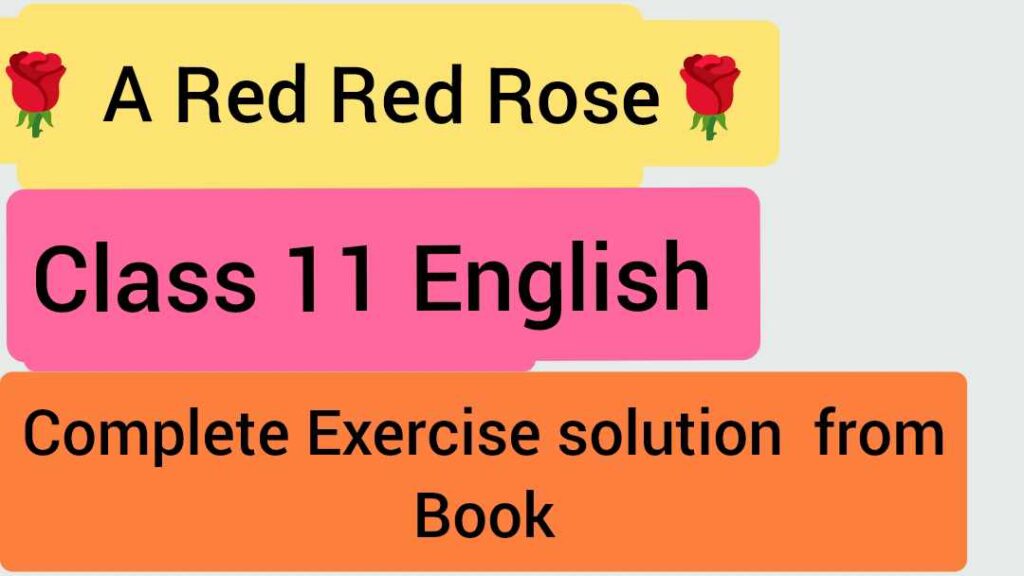A Red Red Rose: Complete Exercise: Class 11
Answer the following questions.
a. To which two things does the speaker compare his love in the first stanza?
Ans: The speaker compares his love in the first stanza with a red rose and melody.
b. What does the speaker promise in the second and third stanzas?
Ans: The speaker promises to continue his love till the sea goes dry and the rock melts in the second and third stanzas.
c. What imagery does he use in his promise, and why do you think he uses such language?
Ans: He uses the imagery of sea, sand and rock in his promise. He uses such language to prove his deep love.
d. In the last stanza, what event is about to happen by mentioning the number of miles?
Ans: We guess that lovers are going very far from each other.
e. Which image in the poem do you find the most memorable or surprising and why?
Ans: The image of the red rose in the poem I find the most memorable because he emphasizes it by using double red. He wants to show the extra quality of his beloved by using it.
Reference to the context
a. What can you infer about the speaker’s devotion to his beloved from the following lines?
And I will come again, my love, Tho’ it were ten thousand mile!
Ans: We can see the speaker’s deep love and respect towards his beloved from the lines. He may be very far from her but he is ready to walk ten thousand miles to meet her.
b. What is the theme of the poem?
Ans: The theme of the poem is the speaker’s deep love and respect towards his beloved. He may be very far from her but he is ready to walk ten thousand miles to meet her.
c. Paraphrase the whole poem into simple prose form.
Ans: In the poem, the author expresses his deep love for the person he loves. He compares his love to a bright and beautiful red rose. The speaker describes his love as enduring and promises to love the one he loves until the sea dries up and the rocks melt in the sun. The poem conveys a feeling of undying love and devotion.
d. Literary devices are tools that enable the writers to present their ideas, emotions, and feelings and also help the readers understand those more profound meanings.
Analyse the poem in terms of the literary devices such as simile, symbolism, imagery, alliteration, and assonance.
Ans: This poem is known for its wonderful use of various literary devices. Here are some examples:
Simile:
The poet compares his love to a red rose, using the word “like” for comparison. This comparison helps the reader understand the intensity and beauty of his love.
repeat:
The phrase “O my Luve” is repeated throughout the poem, emphasizing the deep affection and emotional connection felt by the speaker.
Alliteration spells:
The repetition of consonants in words that are close together creates a musical effect. For example, the “deep” and “dreamy” in the sentence “And I will still love you, baby / Until the sea dries up” creates an allusion.
metaphor:
The whole poem can be considered as a metaphor for the permanence of love. The speaker compares his love to the rose, emphasising its beauty and its lasting impact on him.
Hyperbola:
The poet uses exaggeration to express the intensity of his love. For example, when he says that he will love his beloved until the sea runs dry, it is an exaggeration to emphasise his deep and lasting feelings.
e.What is hyperbole? Explain its purpose citing examples of hyperbole used in the poem.
Ans: Hyperbole is a phrase in which exaggeration is used for emphasis or dramatic effect. It is a popular literary tool used to create emphasis, evoke strong emotions, or add humour to text.
The poet uses exaggeration to express the intensity of his love. For example, when he says that he will love his beloved until the sea runs dry, it is an exaggeration to emphasise his deep and lasting feelings.
f. What is refrain? Why is it used in the poem? Explain citing an example from the poem.
Ans: In literature, a refrain is a line or phrase that is repeated at regular intervals throughout a poem or song. It adds rhythm, emphasis, and structure to the piece, often serving as the main chorus or thematic element.
In the poem “A Red, Red Rose” by Robert Burns, the refrain is a repeating line that appears at the end of each stanza. The refrain of this poem is: “And I’ll love you again, honey.” This line emphasizes the speaker’s undying love for the person to whom the poem is directed.
Reference beyond the text
a. What kind of love is expressed in “A Red, Red Rose”?
Ans: In the poem, the author expresses his deep love for the person he loves. He compares his love to a bright and beautiful red rose. The speaker describes his love as enduring and promises to love the one he loves until the sea dries up and the rocks melt in the sun. The poem conveys a feeling of undying love and devotion.
The speaker’s deep love and respect towards his beloved. He may be far from her but is ready to walk ten thousand miles to meet her.
b. Do you think that love has power? Why do the poets compose poems addressing their beloved?
Ans: Well, love is often considered to have a powerful impact on individuals and relationships. It can inspire people to do great things, overcome obstacles and make positive changes in their lives.
Poets often write poems to their loved ones because love is a deep and intense emotion that is difficult to express in ordinary language. Poetry allows them to convey their deepest feelings, emotions and experiences in a more artistic and meaningful way.
c. Poetry is the expression of feeling and emotions. Explain.
Ans: Poetry is really a form of artistic expression that allows individuals to convey their feelings and emotions through the use of language and images.
It is a way to communicate and connect with others on a deeper level, as well as to explore and understand one’s own emotions. Poetry often uses various literary devices such as metaphor, simile and symbolism to create vivid and evocative images.
By carefully selecting words and arranging them in unique and creative ways, poets are able to capture and convey complex emotions and experiences. The rhythm, rhyme, and structure of a poem also contribute to its overall emotional impact.
Through poetry, individuals can explore and express a wide variety of emotions, from joy and love to sadness, grief, anger, and even despair. It allows for a deeper exploration of the human experience and provides a way to process and understand our own emotions and the world around us.

